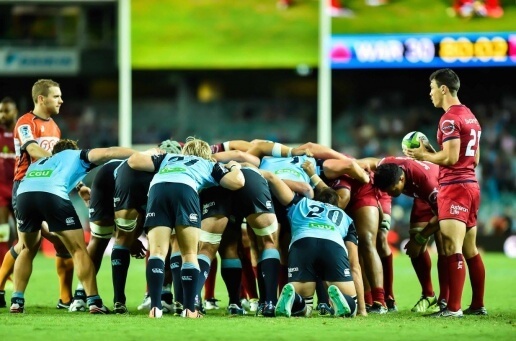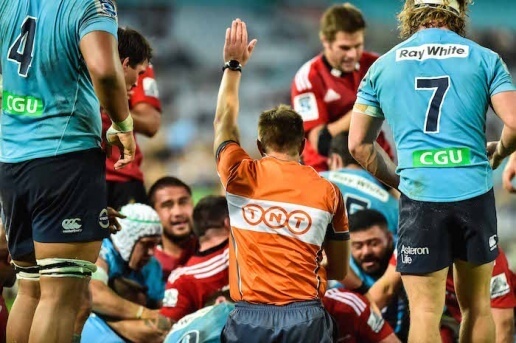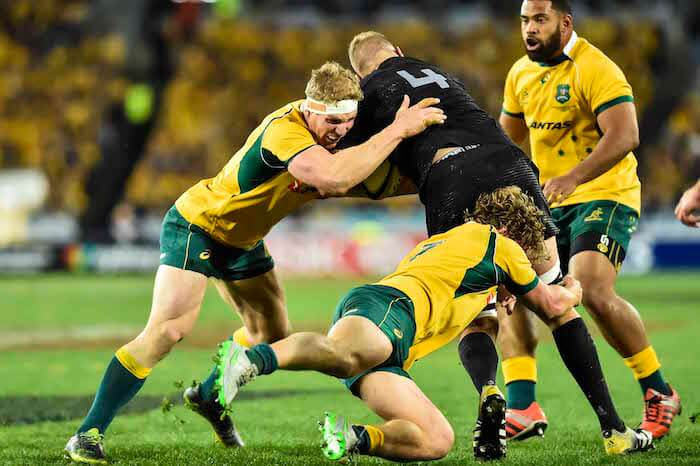Scheduled Website Maintenance
We’re currently in the process of moving to a new and improved server environment. During this transition, the website may experience brief interruptions or temporary outages.
We appreciate your patience while we complete this upgrade. Service will return to normal shortly, with improved performance and reliability.
Thank you for your understanding.
It is a truism well accepted that if rugby league is checkers, then rugby union is chess. The supporting evidence is plentiful, none more so than the legal structure of rugby. A modern referee has to have an understanding of at least some of the following:
- The Laws of the Game – 212 pages
- Law Clarifications – eight alone in 2015
- Competition Rules – Sydney Juniors, who play for massive sheep stations each weekend – 71 pages
- Pathway Laws – 16 pages
- Law Regulations (World Rugby Handbook) – 560 pages. That is NOT a typo; and
- Game Management Guidelines – 9 pages.
The referee needs to know the Law, apply it, ensure the game is enjoyed by all involved, and everyone behaves themselves, all while running around with the players. In other words, if you’re the offspring of a High Court judge, a copper, a cruise director, a pre-school teacher and a cross-country runner, you should be refereeing.
If you’re reading this then it’s a fair bet you’re already a rusted on rugby tragic so hats off to you. This means there’s a good chance you’ll know about some of the legal documents above, but I suspect you will not have seen all of them. Today, we’re going to focus on the ARU’s Game Management Guidelines (GMGs), and although this humble document is only nine pages, it packs a punch.
Each year GMGs are updated, and they reflect the current thinking about how the Laws should be interpreted. The ARU’s thoughts usually align with that of World Rugby and SANZAAR, but not always. This year, there appears to be an alignment, which will assist when watching matches outside our jurisdiction, although be warned, the northern hemisphere supposedly isn’t adhering to these principles until the end of their current season.
Some homework first. If you are not up to speed with the major 2016 Law changes, have a quick read of this:
https://www.greenandgoldrugby.com/5-key-law-changes-need-know/
AREAS OF EMPHASIS
DEATH OF THE JACKAL
Plenty of changes at the breakdown, some subtle, some obvious, and some an insight into the future. The most significant for me – the beginning of the end of the jackal. Bearing in mind the trial Laws proposed for the 2016 NPC, where the tackler has to enter through the gate like everyone else, the following change suggests there is a plot to rid the world of number 7s. Nothing to do with the fact that – subject to the odd exceptions coming out of the valleys (albeit under a Kiwi coach) – the best 7s in world rugby live south of the equator….
It reads as follows:
“A tackler who regains his feet must get up and on the ball before attacking support players arrive. If not and they interfere, this is a PK against the tackler. The tackler must play the ball “immediately” in Law – this is now defined as before attacking support players arrive”.
Seems simple enough, but a couple of key points stand out:
- “Immediately” is now defined, sort of. If the attacking team is tardy, it’s a long time. If they’re effective, it’s but a moment; and
- The jackal doesn’t have to beat the ruck, just the other team. In other words, a ruck does not need to form to extinguish the jackal’s rights, merely the presence of the jackal’s opponents. This significantly erodes the opportunity for the jackal, and tips the balance of power to the team in possession. It will be fascinating to see how the Pococks of the world adjust.
For the jackal to be successful and earn a penalty for holding on, the following will need to occur:
- Be in a position of strength (on feet, with no hands or elbows past the ball on the ground), and
- Attempt to lift ball up, and
- Survive the cleanout.
Also at the breakdown:
- The team in possession must stay on their feet, or roll away. Having hands on the ground is not acceptable – their weight must be on their feet; and
- Pillars must not have hands on the ground ahead of the offside line.
EVERYTHING OLD IS NEW AGAIN
After much discussion, the maul has been tidied up. For the purist, this is back to the way they were and the way the Laws had always been, but just like the naughty red-haired kid in the corner, some people needed it spelled out to them S-L-O-W-L-Y.
Key points:
- The ball can only be moved backwards hand-to-hand once the maul has formed. A player is not allowed to move/slide to the back of the maul when in possession of the ball;
- The ball can be moved backwards hand-to-hand once the maul has formed; and
- Attacking players must join from behind or alongside the hind-most teammate in the maul – they must not join in front of the player in the maul with the ball.
Straightforward? Yep. Easy to do. Not so much…. It’s all in the timing, especially when a maul is formed at the lineout. It means the ripper must be part of the lineout BEFORE taking possession. It should create more of a contest, at least during maul formation, and more room for error by the attacking team, as they need to get both their positioning correct, and manage the transfer of the ball to the rear of the maul.
Round 1 of Super Rugby suggests teams have already made changes, but the execution needs work. Still plenty for the referees to have to watch, so I’m sure there will be instances where it’s not quite right, but play will continue. Cue rant from “wronged” coach.
SIMULATION (a.k.a. “the soccer clause”)
 Law 10.2 (d):
Law 10.2 (d):
“A player must not commit any act that may lead the match officials to consider that that player was subject to foul play or any other type of infringement committed by an opponent. Sanction: Penalty kick”.
This one’s a special, so it gets its own little piece of turf. If you need an example, head to any soccer match. If you need a rugby example, have a look at Michael Hooper’s judiciary moment in Argentina. That’s a classic TMO 10.2 (d) moment and would have, should have, seen our little blue and white friend dealt with more harshly.
Some might say Beale’s effort against the Reds deserved a sanction under this Law, but I think not. There was clearly contact from the defender, plus the TMO and referee discussed whether a sanction was required against Goromaru-san. They decided against it, but that doesn’t automatically mean a sanction against Beale either.
I suspect we won’t see many penalties for simulation, as it’s largely a deterrent, and also provides officials with a weapon for a post-match citing. I would expect that a player in that situation should book a long holiday as the first defendant on such a charge will become the pin-up for the new Law, and that won’t be a good thing for them.
As an aside, one of the authors of the GMGs is one Angus Gardner Esquire, so I’d say he’d be somewhat aware of the correct interpretation.
SCRUMS
The best chance now for a scrum turnover is not a legal 90-degree wheel, as in 2016 that is just a reset, but when the ball is at the #8’s feet and the scrum is not moving. In this situation, the referee will call “Use it”. If the team in possession does not do so immediately, it’s a turnover scrum.
The second best chance is as a result of the 30-second rule. Both teams must be ready in the “Crouch” position 30 seconds from the referee making the mark. This has been used with good effect in the NRC, but could be a killer for those south of the equator in the continent of Africa. Expect all sorts of mischief from front rowers, so much so that a free kick in this situation may become quite common.
Finally, don’t forget that advantage can now be played when a scrum collapses or is popped, subject to safety.

BITS’N’BOBS
Before you smash your new wide-screen with a stubby or order a hit on the referee, remember these little gems:
- A ball stripped from an attacking player is no longer considered a knock-on;
- Neck rolls (no, not the back of a prop’s head. Yes, I thought that too) are verboten, as we saw in RWC, and that has been re-emphasised. Similarly, the mid-2015 clarifications around aerial contests and dirty cleanouts (i.e. shoulder charges at the breakdown) have been formalised;
- This one’s a ripper, and it will trip up someone sooner or later, so read it carefully:
“If a try is scored close to time expiring, so long as the conversion is kicked (boot striking ball) before time expires, there will be a restart. A team may decline to take the conversion so long as they indicate this before time expires. In this case, there will be a restart. The kicking team cannot kick the ball out on the full or not 10 metres etc to end the game. The game will continue with appropriate sanction options given to the non-kicking team.”. Someone will stuff this up – it’s just a question of who it is. Anyone prepared to pick a winner?
For those really keen to haunt the interwebs, the ARU’s 2016 GMGs will eventually turn up here in a week or two. If you get bored while you are waiting, you could always read last year’s version: http://www.rugby.com.au/Referees/Laws.aspx
I would write more, but I’ve just had a glance at my Richard Graham Doomsday clock, and it has just moved from five minutes to midnight, to three minutes to midnight. Time to batten down the hatches.


